Global smartphone shipments are set to grow to just over 1.7 billion in 2021, up from 1.47 billion in 2016, according to new estimates from IDC’s Worldwide Quarterly Mobile Phone Tracker.
IDC indicates that first-time users, and a rather stagnant two-year replacement cycle will drive a sluggish five-year annual growth rate of 3.3 percent.
“The big inflection point that everyone is watching for is when the smartphone market experiences its first year-over-year decline,” Ryan Reith, program vice president with IDC’s Worldwide Quarterly Mobile Device Trackers, commented. “We believe the two main catalysts for continued growth are bringing first-time users onto a smartphone and maintaining life cycles that are close to two years. At the end of 2016 we estimated that about half of the world’s population was using a smartphone, which leaves plenty of room for additional first-time users.”
“And, despite very high saturation levels in mature markets like North America, Western Europe, Korea, and Japan, we still see the majority of users replacing their handsets roughly every two years,” he added. “We expect these trends will hold through the forecast.”
IDC noted Android continues to hold a lion’s share of the OS market, with device shipments up 2.3 percent in 2017 for 85.2 percent market share. Shipments of Apple’s iOS devices were up 1.5 percent year over year, for 14.6 percent market share.
IDC doesn’t call for much change in the coming years, as it estimates Android shipments will grow 3.6 percent in 2021 for an 85.5 percent market share, compared to a 0.8 percent increase of iPhone shipments for a 14.4 percent market share.
However, the report notes that Apple’s anticipated nominal 1.5 percent growth in 2017 is a large improvement over the 7 percent decline of iPhone shipments in 2016.
IDC also indicated 2018 will be a bright year for Apple, as the arrival of the iPhone 8 will entice a high number of upgrades next year. That will combine with new 7S and 7S+ models to spur a projected 9.1 percent growth in 2018.
The new iPhone 8 will reportedly launch September 12, with forecasters expecting features such as a new fingerprint sensor and memory tiers with a 512 GB high-end option. More on that here.
While Android may dominate the market share of smartphone shipments, the story is different when looking at market value based on non-subsidized device retail pricing, according to the report.
IDC forecasts Apple will own 36 percent of the device market value by 2021, equaling about $180 billion. This figure of more than half of the combined value of all other Android OEMs together, and doesn’t include revenue from apps or services.
That may not be surprising given the newest iPhone is expected to carry a hefty price tag of around $1,000.
“The high-end spectrum of the smartphone market shows no signs of slowing down as we expect the average selling price of a smartphone to increase over 7 percent in 2017,” Anthony Scarsella, research manager with IDC’s Worldwide Quarterly Mobile Phone Tracker, noted. “Premium phablet offerings from a variety of vendors look to be the main driving force behind the growth of devices with screens 5.5 inches and larger, which are set to grow over 34 percent in 2017 across all operating systems.”
“The average selling price of these devices is also expected to increase 9 percent as we await the arrival of ultra-premium devices such as the iPhone 8, Note 8, V30, Essential Phone, and the second-generation Pixel,” he added. Read more about Samsung’s Galaxy Note 8 here.
Scarsella also noted that large screens will continue to become more popular, and phablets are expected to control just over 51 percent of the smartphone market by 2021.




